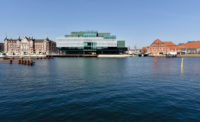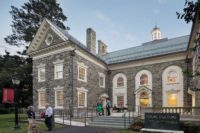Curragh Racecourse by Grimshaw
County Kildare, Ireland

The new grandstand is the heroic centerpiece of the reorganized racing grounds. Its dramatic cantilevered roof is clad in perforated copper-colored aluminum panels.
Photo © Sportsfile

The new grandstand is the heroic centerpiece of the reorganized racing grounds. Its dramatic cantilevered roof is clad in perforated copper-colored aluminum panels.
Photo © Roger O'Sullivan

Image courtesy Grimshaw



Architects & Firms
If you caught some of the Wimbledon tournament last month, you may have noticed a new retractable roof over Court 1. That roof, along with other improvements to the stadium just beside Centre Court, was designed by Grimshaw, which has also developed a master plan for the All England Lawn Tennis Club. The global firm, known mainly for highly complex transportation facilities and innovative science and educational buildings, is beginning to flex its muscle when it comes to athletics. In County Kildare, Ireland, Grimshaw has just completed another sporting venue—with another impressive roof.
Officially opened at the end of May, the reimagined Curragh Racecourse, which includes a dramatic grandstand, was designed to “grow from the landscape,” according to Kirsten Lees, managing partner of Grimshaw’s London office. (The firm has recently seen a change in leadership, with Andrew Whalley succeeding founder Sir Nicholas Grimshaw as chair earlier this summer.)
Set amid gently rolling natural grasslands with the Wicklow Mountains in the distance, the historic Curragh has long been one of Ireland’s most important Thoroughbred racecourses. Working with Dublin-based architects Newenham Mulligan & Associates, Grimshaw reorganized the previously linear grounds by relocating the entrance to bring visitors directly to the heart of the action. A new parade ring, where the horses meet their jockeys before a race, now has views to Curragh’s famous track. Dismal low spaces in the former grandstand, which was well beyond its serviceable life—“the facilities didn’t match the track,” says Lees—have been replaced with a welcoming double-height atrium at the angled rear of the new grandstand. “It’s about the spectacle,” Lees asserts. “Everyone’s dressed up in their finery.”
But it is the grandstand’s soaring roof that is the star of the show. Topping a precast-concrete superstructure that is exposed throughout much of the public space of the building, and covering an area of 77,500 square feet, the underside of the shapely, surprisingly thick roof surges to a razor-like edge, creating a gravity-defying illusion. “You read it not as a volume but as a planar surface,” says Rossella Nicolin, associate director at AECOM Sports, which provided the structural and m/e/p engineering.
A series of steel Pratt trusses composed of standard open sections form the sweeping roof, which is 12½ feet at its deepest, where mechanical equipment is housed. Though relatively simple, the shape and layout of the trusses were developed through parametric scripting tools. This allowed many structural options to be rapidly assessed and optimized. For instance, adopting shallow steel trusses would have yielded a very heavy and uneconomical structure. Thanks to tapered plate girders along the edge, the roof thins to just under 6 inches as it cantilevers over the plein air seating beneath it. At the center, the span is 88½ feet, but at one corner, at the western end, a double cantilever supported by a diagonal spine truss spans nearly 148 feet.
Inspired by the Curragh plains, materials for the new grandstand reflect the rural context. The roof is clad in copper-colored aluminum panels. On the soffit, those panels are perforated to provide a visual connection to the trusses while permitting ventilation through fans within the roof. Rather than flat panels, the designers opted for sinusoidal ones that have greater rigidity and allow supports to be hidden inside of the curve. A movement joint across the roof is barely noticeable.
The edge detail was developed to coordinate structural requirements with cladding elements and the rainwater-collection system, which utilizes runoff from the grandstand roof to provide all peak graywater requirements on a race day.
Despite taking cues from its surroundings, the roof’s floating horizontal form highlights the contrast between the natural undulating topography around the Curragh and the precision of the man-made. Says Nicolin, “We took a simple approach, but, because of some key solutions and refined detailing, it turned out to be an extremely elegant and streamlined structure.”











